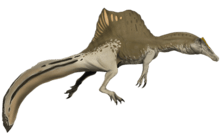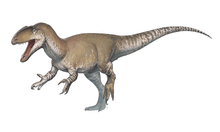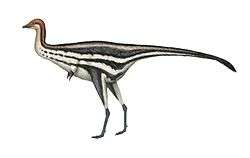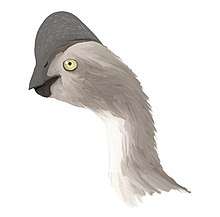Bonapartenykus
Bonapartenykus (meaning "Bonaparte's claw", named after José Bonaparte)[2] is a genus of alvarezsaurid theropod dinosaurs known from the Late Cretaceous (Campanian/Maastrichtian stage) Allen Formation of northwestern Patagonia, Argentina. The type species is B. ultimus.[3] An adult female of B. ultimus has been discovered with two eggs that may have still been inside its oviducts,[1][2] although some evidence suggests that the eggs may have been incubated in a nest.[4] The size of the adult female has been estimated as at least 8.5 feet (2.6 m),[5][2] and the weight of Bonapartenykus has been estimated as 100 pounds (45 kg).[1] Its diet probably consisted of insects.[1] Paleontologist Fernando Novas compared its bones to those of the ñandú, a modern-day Patagonian flightless bird.[6]
| Bonapartenykus | |
|---|---|
| Scientific classification | |
| Kingdom: | Animalia |
| Phylum: | Chordata |
| Clade: | Dinosauria |
| Clade: | Saurischia |
| Clade: | Theropoda |
| Family: | †Alvarezsauridae |
| Genus: | †Bonapartenykus Agnolin et al. 2012 |
| Species: | †B. ultimus |
| Binomial name | |
| †Bonapartenykus ultimus Agnolin et al. 2012 | |
The eggs of Bonapartenykus were considered unique enough for them to be given a new parataxonomic name, Arriagadoolithus, which was classified in a new oofamily, the Arriagadoolithidae, so named for the owner of the site where the discovery was made.[3][4]
References
- Bob Strauss. "Bonapartenykus". About.com. The New York Times Company. Retrieved April 19, 2012.
- Jennifer Viegas (April 11, 2012). "Dinosaur Mom Died with Eggs Still Inside Her". Discovery News. Discovery Communications. Retrieved April 19, 2012.
- Federico L. Agnolin; Jaime E. Powell; Fernando E. Novas & Martin Kundrát (June 2012). "New alvarezsaurid (Dinosauria, Theropoda) from uppermost Cretaceous of north-western Patagonia with associated eggs". Cretaceous Research. 35: 33–56. doi:10.1016/j.cretres.2011.11.014.
- Nola Doyle-Burr (April 11, 2012). "Which came last, the dinosaur or the egg?". The Christian Science Monitor. Retrieved April 19, 2012.
- Holtz, Thomas R., Jr.; Rey, Luis V. (2007). Dinosaurs: The Most Complete, Up-to-Date Encyclopedia for Dinosaur Lovers of All Ages (). New York: Random House. ISBN 978-0-375-82419-7.
- "Bird-like dinosaur found with eggs in Patagonia". BBC News. BBC. April 12, 2012. Retrieved April 19, 2012.














